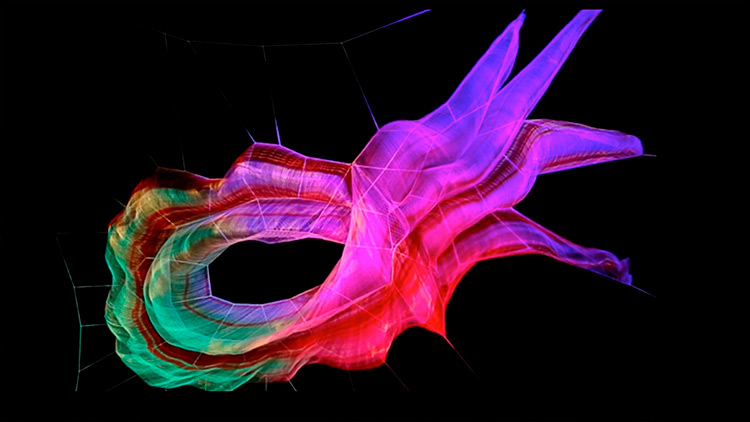
Janet Echelman / USA
1.8
Escultura de Luz
CENTRO CULTURAL DEL MÉXICO CONTEMPORÁNEO
Leandro Valle 20
La escultura de Janet Echelman "1.8" es una forma flotante monumental, que late con el clima y el viento cambiantes y que nos invita a detenernos y contemplar una manifestación física de una inter-conectividad de los opuestos – suave y duro, la tierra y el cielo, cosas que podemos controlar y fuerza por encima de nosotros.
El concepto de obra de arte surge de datos científicos a partir del terremoto y tsunami en Japón en el año 2011 y la idea de que todos estamos conectados entre los sistemas naturales de la tierra. El Studio Echelman generó la forma 3D de la escultura que utiliza los datos de NASA y NOAA que midieron los efectos del terremoto e incluyendo los de las olas del tsunami a través de todo el océano Pacífico. Las vibraciones resultantes momentáneamente aceleraron la rotación de la tierra, acortando la duración del día por 1.8 micro-segundos, lo que fue el catalizador para la escultura 1.8.
Dicha escultura a sido expuesta en Londres (2016) y San Diego (2016). Su presentación en la CDMX, será su tercera instalación.
La escultura es completamente suave y construida con dos tipos de fibra técnica, haciéndola lo suficientemente ligera de peso para poder enlazarla directamente con estructuras existentes sin ningún refuerzo extra. Polietileno de peso molecular sumamente alto (UHMWPE), una fibra más de 15 veces más fuerte que el acero por peso, conforma la parte estructural de la obra de arte. Mezclas de colores creadas especialmente de cordeles de polyester de alta tenacidad forman el resto de la red escultural. Echelman combina esto con luz de color programada para crear la obra de arte final.
Janet Echelman's "1.8" sculpture is a monumental, floating form that pulses with the changing wind and weather and invites you to pause and contemplate a physical manifestation of interconnectedness of opposites – soft with hard, earth with sky, things we control with the forces beyond us.
The concept of the artwork stems from scientific data sets of the 2011 Japan earthquake and tsunami and the notion that we are all connected between the earth’s natural systems. Studio Echelman generated the 3D form for the sculpture using data sets of the tsunami’s wave heights rippling across the entire Pacific Ocean. The resulting vibrations momentarily sped up the earth’s rotation, shortening the length of the day by 1.8 micro-seconds, which became the catalyst for the 1.8 sculpture.
The sculpture has traveled to exhibitions in London (2016) and San Diego (2016), and the Mexico City exhibition marks its third installation.
The sculpture is completely soft and constructed from two types of technical fiber, making it lightweight enough to lace directly into existing structures without extra reinforcement. Ultra high molecular weight polyethylene (UHMWPE), a fiber more than 15 times stronger than steel by weight, makes up the structural portion of the artwork. Custom color blends of high-tenacity nylon twines make up the remainder of the sculptural net. Echelman combines these with programmed colored light to create the final artwork.

Janet Echelman es una artista que desafía la categorización. Su trabajo hace una intersección a través de los límites de la Escultura, Arquitectura, Diseño Urbano y Planeación, Ciencia Material, Ingeniería Estructural y Aeronáutica y Ciencia de Cómputo. Ella crea escultura experiencial a la escala de edificios que se transforman con el viento y la luz. El arte cambia de ser un objeto que sirve para verlo, a un entorno vivo en el que se puede uno perder. Utilizando materiales poco probables desde una red para pescar a partículas de agua atomizadas, Echelman combina la artesanía antigua con el software de diseño computacional para crear obras de arte que se han convertido en puntos focales de la vida urbana en cuatro continentes.
Janet Echelman is an artist who defies categorization. She creates billowing sculpture at the scale of buildings, choreographed by wind and light. The art shifts from being an object you look at, to a living environment you can get lost in. Using unlikely materials from netting to atomized water particles, Echelman combines ancient craft with cutting-edge engineering and material science to create focal points for urban life on five continents.
Echelman was named an Architectural Digest Innovator for "changing the very essence of urban spaces." Her TED talk "Taking Imagination Seriously" has been translated into 34 languages and viewed by millions. Echelman’s art ranked #1 on Oprah’s “List of 50 Things That Make You Say Wow!” and received the Smithsonian American Ingenuity Award.
Echelman’s path has been nonlinear. After graduating from Harvard, she applied to seven art schools, and was rejected by all of them. So she decided to create a life as an artist herself. For five years, she painted in a Balinese village while studying craft traditions. But she didn’t find her full voice as an artist until her paints went missing on a Fulbright in India -- which forced her to embrace an unorthodox new art material.
